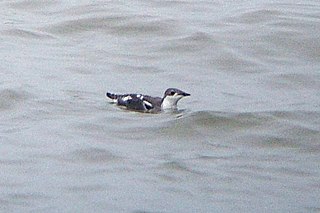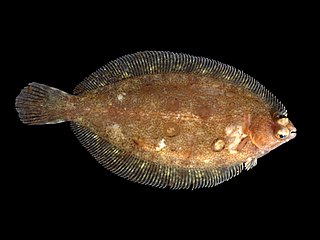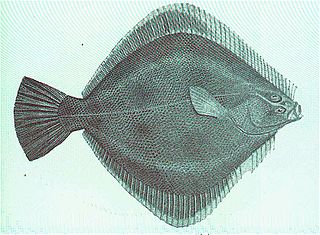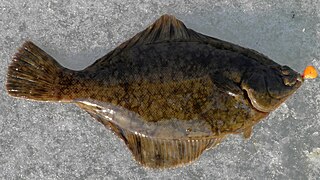
Flounders are a group of flatfish species. They are demersal fish, found at the bottom of oceans around the world; some species will also enter estuaries.

The marbled murrelet is a small seabird from the North Pacific. It is a member of the family Alcidae, which includes auklets, guillemots, murres and puffins. It nests in old-growth forests or on the ground at higher latitudes where trees cannot grow. The marbled murrelet has declined in number since humans began logging its nest trees in the latter half of the 19th century. The decline of the marbled murrelet and its association with old-growth forests, at least in the southern part of its range, have made it a flagship species in the forest preservation movement.

The long-billed murrelet is a small seabird from the North Pacific. The genus name Brachyramphus is from Ancient Greek brakhus, "short", and rhamphos, "bill". The species name perdix is Latin for "partridge" Pallas described this auk as Magnitudine Perdicis. "Murrelet" is a diminutive of "murre", a word of uncertain origins, but which may imitate the call of the common guillemot.

Pleuronectidae, also known as righteye flounders, are a family of flounders. They are called "righteye flounders" because most species lie on the sea bottom on their left sides, with both eyes on their right sides. The Paralichthyidae are the opposite, with their eyes on the left side. A small number of species in Pleuronectidae can also have their eyes on the left side, notably the members of the genus Platichthys.

Demersal fish, also known as groundfish, live and feed on or near the bottom of seas or lakes. They occupy the sea floors and lake beds, which usually consist of mud, sand, gravel or rocks. In coastal waters they are found on or near the continental shelf, and in deep waters they are found on or near the continental slope or along the continental rise. They are not generally found in the deepest waters, such as abyssal depths or on the abyssal plain, but they can be found around seamounts and islands. The word demersal comes from the Latin demergere, which means to sink.

The lemon sole is a flatfish of the family Pleuronectidae. It is native to shallow seas around Northern Europe, where it lives on stony bottoms down to depths of about 1,400 metres (4,600 ft). It grows up to 65 centimetres (26 in) in length and reaches about 19 kilograms (42 lb) in weight.

The New Zealand sand flounder is a righteye flounder of the genus Rhombosolea, found around New Zealand in shallow waters down to depths of 100 m.

The winter flounder, also known as the black back, is a right-eyed ("dextral") flatfish of the family Pleuronectidae. It is native to coastal waters of the western north Atlantic coast, from Labrador, Canada to Georgia, United States, although it is less common south of Delaware Bay. It is the most common near-shore (shallow-water) flounder in the waters from Newfoundland down through Massachusetts Bay, reaching a maximum size around 61 cm in length and 2.25 kg in weight. The species grows larger on Georges Bank, where they can reach a length of 70 cm and weight of 3.6 kg. Although winter flounder historically supported large commercial and recreational fisheries, biomass and landings have decreased since the 1980s.

The marbled grouper, donkey fish, mutton hamlet, rockhind and sicklefish grouper, is a species of marine ray-finned fish, a grouper from the subfamily Epinephelinae which is part of the family Serranidae, which also includes the anthias and sea basses. It is a predatory reef fish which is found in the Western Atlantic Ocean.

The brown-marbled grouper or tiger grouper is a benthic marine fish which belongs to the family Serranidae or also known as the groupers.
Glugea is a genus of microsporidian parasites, predominantly infecting fish.

The European flounder is a flatfish of European coastal waters from the White Sea in the north to the Mediterranean and the Black Sea in the south. It has been introduced into the United States and Canada accidentally through transport in ballast water. It is caught and used for human consumption.
P. americanus may refer to:

Fishing within the Bailiwick of Guernsey is common place. The bailiwick is made up of several islands in the Channel Islands, namely.

The Kamchatka flounder, Atheresthes evermanni, is a flatfish of the family Pleuronectidae. It is a demersal fish that lives at depths of between 20 metres (66 ft) and 1,200 metres (3,900 ft). Its native habitat is the temperate waters of the northern Pacific. It can grow as long as 100 centimetres (39 in) in length, and can weigh up to 8.5 kilograms (19 lb).

Pseudopleuronectes is a genus of righteye flounders mostly native to the northwestern Pacific Ocean with one species found in the northwestern Atlantic Ocean.
The yellow striped flounder, Pseudopleuronectes herzensteini, is a flatfish of the family Pleuronectidae. It is a demersal saltwater fish that occurs in the temperate waters of the northwestern Pacific, from the Sea of Japan to the Kuril Islands, Sakhalin, Korea, the Yellow Sea, Gulf of Bohai and the East China Sea. It can grow up to 50 centimetres (20 in) in length, though commonly it reaches around 28.5 centimetres (11.2 in); its maximum recorded weight is 1.3 kilograms (2.9 lb) and its maximum reported lifespan is 15 years.

Pseudopleuronectes obscurus, or dark flounder is a flatfish of the family Pleuronectidae. It is a demersal fish that lives on salt bottoms in the temperate waters of the northwestern Pacific, from Hokkaido to the Kuril Islands, the Sea of Okhotsk, Sakhalin and the Tatar Strait to the northeastern coast of Korea and the Yellow Sea. It can grow up to 56 centimetres (22 in) in length, though it more commonly reaches around 35 centimetres (14 in), and its maximum recorded weight is 2.6 kilograms (5.7 lb).
The cresthead flounder is a flatfish of the family Pleuronectidae. It is a demersal fish that lives on bottoms in salt water in the temperate waters of the northwestern Pacific, from the southern parts of the Sea of Okhotsk and the Kuril Islands to Korea and northern Honshu, Japan. It can grow up to 50 centimetres (20 in) in length, though it more commonly reaches lengths of around 32.5 centimetres (12.8 in). Its maximum recorded weight is 2.5 kilograms (5.5 lb).

Metridium senile, or frilled anemone, is a species of sea anemone in the family Metridiidae. As a member of the genus Metridium, it is a type of plumose anemone and is found in the seas off north-western Europe and both the east and west coasts of North America.















